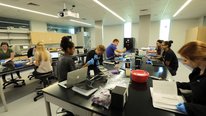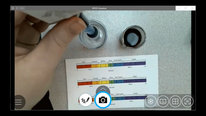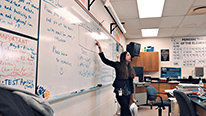- Kristin Cook
- Associate Professor of Science Education
- Presenter’s NSFRESOURCECENTERS
- Bellarmine University
- Akhtar Mahmood
- Professor of Physics
- Presenter’s NSFRESOURCECENTERS
- Bellarmine University
Strengthening STEM Teacher Education Pathways in Kentucky with Collaborative ...
NSF Awards: 1852898
2021 (see original presentation & discussion)
Undergraduate, Graduate
With the support from the National Science Foundation’s Robert Noyce Teacher Scholarship Program, this Capacity Building project at Bellarmine University aims to address the critical shortage of certified STEM teachers in the local public schools by strengthening STEM teacher education pathways in Kentucky by bringing together the key stakeholders to build and strengthen the infrastructure, by forming new partnerships, recruitment pipelines, and retention strategies that will lead to increasing the number of STEM teachers in high-need schools in the targeted STEM fields. Our goals included the following:
Goal 1: To develop a pipeline into STEM teaching programs via high school STEM and Education Academies and a partnership agreement for community college students with wrap-around supports to ensure their success.
Goal 2: To develop a partnership agreement with high schools to hire the future Bellarmine-Noyce Scholars as certified Mathematics and Science teachers to teach in high-need schools when we implement the Bellarmine Noyce Scholars Program.
Goal 3: To develop an early-start Master of Arts in Teaching certification curriculum program for the STEM students with recruitment from BU’s STEM students, as well as from prospective high school students from high school STEM and Education Academies.
Goal 4: To develop a STEM summer camp and internship agreement with the Kentucky Science Center for STEM students and future Bellarmine Noyce Scholars.
Goal 5: To design and develop a plan along with our partners and collaborators for recruiting, preparing, and supporting new STEM teachers in high-need schools to expand and diversify the pool of new STEM teacher candidates.
Related Content for Noyce Capacity Building Project at Bellarmine University
-
 2020Supporting PBL Instruction on the US-Mexico Border
2020Supporting PBL Instruction on the US-Mexico Border
Amy Wagler
-
 2020Noyce Scholars and Citizen Science
2020Noyce Scholars and Citizen Science
John Pecore
-
 2020ARISE: Gauging STEM Teacher Preparation, Reducing Attrition
2020ARISE: Gauging STEM Teacher Preparation, Reducing Attrition
Jennifer Carinci
-
 2020Preparing Master Teachers for STEM Digitally-Rich Teaching
2020Preparing Master Teachers for STEM Digitally-Rich Teaching
Raffaella Borasi
-
 2019CTI Inspire: Diversifying the STEM Teaching Workforce
2019CTI Inspire: Diversifying the STEM Teaching Workforce
Jomo Mutegi
-
 2021Virtual Science Teaching Strategies in Response to Pandemic
2021Virtual Science Teaching Strategies in Response to Pandemic
Sabrina Stanley
-
 2019Collaboration Beyond Preparation: Developing Lasting Support
2019Collaboration Beyond Preparation: Developing Lasting Support
Allan Feldman
-
 2019Preparing Next Generation STEM Teachers
2019Preparing Next Generation STEM Teachers
Ed Geary


Christine Royce
Professor
Hi there Bellarmine University!,
I greatly enjoyed your video and the use of the different footage from the classroom environments. The collaboration you describe with the sixteen community colleges sounds like a great win-win for both them and your university. The 2X2 plan that was mentioned is interesting to me - is there a common outline of gen eds that are offered at all of the community colleges that articulate and transfer easily to your program? Also, I would be interested in how any education classes that transfer ensure alignment and not repetition of or missing content areas. Thanks in advance!
Catherine Horn
Kristin Cook
Associate Professor of Science Education
Thanks so much for your interest and positive feedback! Our university has worked hard to establish a transfer equivalency list for our community college partners that identify the majority of the general education equivalents. As far as the education courses that transfer in, we had to be flexible in specific ways. For example, our programs split out elementary and middle/secondary students whereas the community college groups them in K-12. Having close and on-going communication is essential in ensuring the 2x2 plans provide students with what they need going into the classroom. Many thanks again!
Catherine Horn
Kelly Costner
I'm interested in knowing more about two components of your plan:
Thanks so much for sharing with us!
Catherine Horn
Kristin Cook
Associate Professor of Science Education
Thank you for your question and interest! In terms of your first question, the development and implementation of the summer camp internship was a success and has led to an ongoing partnership with the Kentucky Science Center that will be promoted and offered to all Bellarmine STEM students indefinitely as a credit-bearing opportunity. In the piloting of this internship experience, ten Bellarmine students majoring in STEM disciplines participated in a summer internship at the Kentucky Science Center. Interns aided camp teachers by providing classroom management and guided instruction time. Data were collected using interviews and survey in which interns were asked demographic information as well as open-ended questions regarding their experience in the internship. Observational data on each student’s summer camp experience and internship activities were collected by the project PI/Co-PI. Additionally, the Kentucky Science Center’s Summer Camp supervisors conducted a quantitative and qualitative assessment of each student intern’s performance at the summer camp. Results not only were promising with regard to increasing STEM majors’ interest in a teaching career, but led to the development of a partnership agreement that specifies the mutually beneficial aspects of the Bellarmine and Kentucky Science Center connection.
Regarding your second question, we aimed to recruit high school students by working with the Academies of Louisville college and career pathways for students in the high-need Jefferson County Public School (JCPS) district, and for hiring and retaining future Noyce scholars in high-need JCPS schools, this goal also incorporates other actions related to expanding and diversifying the pool of STEM teacher candidates.
And I have to ask if you know Dr. Richard Cox, who was recently hired in Education at Winthrop. He is my dear friend and colleague- I hope your paths cross!
Catherine Horn
Kelly Costner
Thanks for the additional info. I'm especially impressed by the fact that your partnership with KSC has become institutionalized as a feature of your educator prep program regardless of grant support. That's a huge outcome!
And, yes--Dr. Cox is a great addition to our team. Glad you were willing to share him with us!
Jill Berg
Leadership Coach, School Improvement Consultant & Author
What a great way to leverage the power of partnerships for an innovative solution to an important problem!
I see this multi-part project as having even more benefits than those you describe. It seems the camp would provide a rich opportunity for your prospective teachers to have extended experience working with kids. In addition, your pipeline may help to diversify the teaching workforce.
I would be curious to hear how you plan to measure impact along the way, since the timeline from HS to teaching is long. What indicators will signal to you that you’re on track with preparing teachers for a satisfying career in STEM teaching?
Catherine Horn
Kristin Cook
Associate Professor of Science Education
Many thanks for your support! You are correct that the pathway from HS to teaching is long, so many supports have been put in place along the way. Some of these include learning communities to support Education + STEM students, RSOs (i.e. "Educator's Rising") students can be involved in that draw from high school and college students with similar interests, Maker Fairs with the campus and external communities, professional development on high-leverage strategies in STEM teaching, strategic placement in diverse field settings, internships at the Science Center, and more.
Catherine Horn
Catherine Horn
Moores Professor and Chair
Thanks, so much, for the work you are undertaking and the really thoughtful way you've represented it in your video. I want to build off of several people's wonderings with two additional questions related to your partnerships with community colleges. I really appreciated what the VP featured in the video talked about with respect to the broader societal motivation that makes such a partnership worthwhile. You also talked about the importance of ongoing communication in building the strength of the partnership. Do you have one or two specific examples of ways (in process) that you have been able to forge those meaningful relationships? Were there existing individual relationships, for example, that you leveraged? Common interest that brought you together? Learning more about how people forge these kinds of relationships I think is really helpful.
Separately, the video mentioned that for some an "early entry pathway" is the preferred approach. What are you all learning in understanding the implications of going all the way through the first 2 years at a community college and then transferring compared with an earlier departure approach?
Appreciate all that is going on at Bellarmine in this space!
Jan Smith
We tried to have the early courses of our STEM ED courses at our local community college but really struggled with numbers and it ended after a few years. One issue was our early courses have field experiences (we are a UTeach replication) What strategies do you use to get your community college students into STEM ed?
Kristin Cook
Associate Professor of Science Education
Hi Jan,
We do have some recruitment happening at the community colleges through foundations courses, but we really rely on our efforts once they arrive at our university in their junior year as a STEM major. At this point, we introduce them to education-focused internships, maker fairs, education RSOs and learning communities. Our 2x2 plans are mapped to allow students to move seamlessly into the Early Entry Master of Arts in Teaching program if they decide teaching is of interest to them.
Further posting is closed as the event has ended.